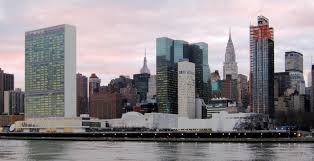Statement of the Representative of the Russian Federation at the Panel Discussion "Transport and transit corridors: time for action"
Esteemed colleagues,
The delegation of the Russian Federation would like to take this opportunity and once again express its support to the resolution of the General Assembly 69/213 "Role of transport and transit corridors in ensuring international cooperation for sustainable development".
Our delegation was among the supporters of this resolution from the very start of the negations on its draft. We are also among the cosponsors of the resolution.
Our country has its reasons for supporting further development of international transport and transit corridors. The geographic position of the Russian Federation determines its unique role in providing transportation between the European and Asian Countries. Considering the ever growing globalization of the international trade and means of transportation both countries and businesses are keen of establishing international transport and transit corridors with regions in Central Asia, Caucasia and China. So far the largest international corridors in Russia include such routes as the North-South corridor (India, Pakistan, Persian Gulf countries, Caspian sea, the European part of Russia and countries of the eastern, central and western parts of Europe) and the Trans Siberian corridor (stretching from central Europe, though Russia and on to Kazakhstan, Mongolia, China and the Korean peninsula). There are also a number of other corridors.
As many of you, I believe know, on January 1, 2015 the Eurasian Economic Community (EAEC) has been created in accordance with the decisions of the Presidents of Russia, Belarus and Kazakhstan. The strategic goal of this Community involves the realization of four economic freedoms – free movement of goods, services, capital and labour including systematic liquidation of remaining barriers in the framework of the Customs Union and the Common Economic Space.
The combined geographical spread of the members of the Community creates an even greater potential for international transport and transit corridors in the direction from East to West and from North to South. However the potential of Community is not fully utilized. According to estimates just a fraction of the total amount of transportation between the EU and Asian-Pacific region is carried out through the corridors of the Community. The major part of transportation is being done through sea.
The transportation by sea is more advantageous in terms of cost, but the speed of land transportation from Western Europe to Eastern parts of Asia is two to three times higher. This land speed advantage may be used. In our view the integration of the transportation systems and the coordinated investment policy aimed at development of key transport and transit corridor projects might serve the purpose. Considering the huge cost of such projects it is now up to the Community country members to decide on its priority areas.
We therefore strongly believe that successful cooperation in the field of transit and transport corridors (with the Eurasian Economic Community being just one potentially good example) would not only contribute to the sustained benefit of the countries of the would, but would also contribute a lot to achieving the Goals of the Sustainable Development Agenda. In particular to Goal 9 (Build resilient infrastructure, promote inclusive and sustainable industrialization and foster innovation) and its sub item 9.1 (Develop quality, reliable, sustainable and resilient infrastructure, including regional and transborder infrastructure, to support economic development and human well-being, with a focus on affordable and equitable access for all) of the Report of the Open Working Group of the General Assembly of the UN on Sustainable Development Goals.
